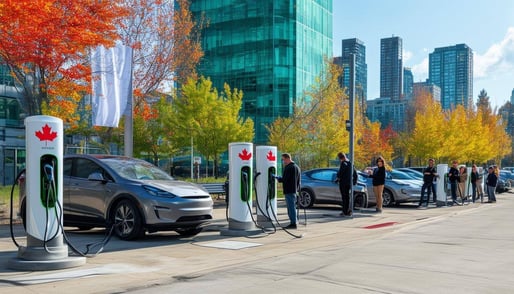Stacking Rebates for Maximum Benefits
As the adoption of electric vehicles (EVs) continues to accelerate, various levels of government in Canada offer incentives to make EV charging infrastructure more accessible and affordable. One of the most effective ways to optimize your savings is by stacking rebates, leveraging both federal and provincial programs. In this blog post, we will explore how to effectively combine the Canadian Federal Rebates, such as the Zero Emission Vehicle Infrastructure Program (ZEVIP), with provincial incentives like those offered by BC Hydro and PlugIn BC.
Understanding ZEVIP and Provincial Rebates
The Zero Emission Vehicle Infrastructure Program (ZEVIP) is a federal initiative aimed at increasing the availability of EV charging infrastructure across Canada. This program provides significant funding to support the installation of EV chargers in multi-unit residential buildings, workplaces, and other private locations. The program can cover up to 50% of total project costs, with higher funding rates available for Indigenous businesses and community groups.
Provincial rebates, such as those offered by BC Hydro and PlugIn BC, provide additional financial incentives to support the deployment of EV charging infrastructure. These programs often target similar projects and can significantly reduce the overall cost of installation.
Stacking Rebates: Federal and Provincial Synergy
One of the most advantageous aspects of these programs is that federal and provincial rebates can be stacked, allowing applicants to maximize their financial support. Here’s how you can do it:
-
Federal Support with ZEVIP:
- Funding Cap: Up to 50% of total project costs, with a maximum of $5,000 per Level 2 charger and up to $100,000 per fast charger, depending on the power output.
- Eligibility: Projects must be located in Canada and comply with local codes and standards. New installations or expansions of existing infrastructure are eligible, but replacements are not.
-
Provincial Incentives:
- BC Hydro and PlugIn BC: These programs offer additional rebates for EV charger installations. For instance, BC Hydro may provide rebates up to 50% of the cost of eligible EV chargers.
- Eligibility: Similar to ZEVIP, these provincial programs require compliance with local codes and aim to support new installations or expansions.
Key Points for Maximizing Stacked Rebates
- Total Government Assistance: According to the ZEVIP guidelines, the total funding from all levels of government (federal, provincial, and municipal) cannot exceed 75% of the total project costs, unless the proponent is an Indigenous business, a non-profit organization, or a municipal, provincial, or territorial government entity. In such cases, the stacking limit is 100% of the total project costs.
- No Double-Dipping on Provincial Rebates: It's important to note that while you can stack federal and provincial rebates, you cannot combine multiple provincial rebates for the same expense. For example, you cannot apply for both BC Hydro and PlugIn BC rebates for the same charger.
Special Considerations for Non-Profit and Indigenous Groups
Non-profit organizations and Indigenous groups have additional advantages when it comes to stacking rebates. These groups can receive up to 100% of their total project costs covered through combined federal and provincial funding. This ensures that these critical projects can proceed without financial barriers, further supporting the transition to sustainable transportation and the broader community benefits that come with it. Some Strata corporations may also qualify as non-profit organizations, provided they are not generating revenues for profit.
Practical Example
Consider a project to retrofit a building that was built before August 2021, electrifying 200 stalls, making it EV Ready, while installing twenty Level 2 EV chargers. Let's say the total cost is estimated at $300,000. Here’s how the funding can be stacked:
- Federal Rebate (ZEVIP):
- 50% of $300,000 = $150,000
- Provincial Rebate (BC Hydro):
- Infrastructure: 200 x $600 = $120,000
- Chargers: $14,000
If the Strata is generating revenues for profit, the total funding would be capped at 75% of the project costs, you can receive $225,000 in combined rebates, leaving only $75,000 to be covered by other sources or the applicant.
If the project is proposed by a non-profit organization or an Indigenous group, the combined federal and provincial funding can cover up to 100% of the total project costs, meaning the entire $300,000 could potentially be covered by the rebates.
Conclusion
Stacking federal and provincial rebates is a powerful strategy to reduce the costs associated with installing EV charging infrastructure. By leveraging programs like ZEVIP alongside provincial incentives from BC Hydro or PlugIn BC, you can maximize your savings and make a significant contribution to sustainable transportation. Non-profit and Indigenous groups have even more opportunities to benefit, with the potential to cover 100% of their project costs through these combined programs.
For more details on how to apply and the eligibility criteria, refer to the ZEVIP Applicant's Guide and the respective provincial rebate programs. Optimizing your approach to stacking these rebates can make the transition to electric vehicles more affordable and accessible for everyone.
Aug 9, 2024 6:18:06 PM


Comments